Papers by William H Meyers
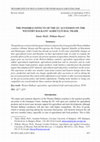
Economics of Agriculture, Dec 31, 2013
The quickest accession to the European Union is a shared, short term goal of the Western Balkan c... more The quickest accession to the European Union is a shared, short term goal of the Western Balkan countries (Albania, Bosnia and Herzegovina, the Former Yugoslav Republic of Macedonia and Montenegro, while Croatia has already accessed). It will cause remarkable changes on their agricultural sector and therefore on their agricultural trade. In order to evaluate the possible effects of the accession, the present situation of agriculture should be analysed. This paper gives an overview of the Western Balkan countries' agriculture (agricultural value added, agricultural employment, agricultural production and its structure) and its trade relations (major trade partners, major products, trade balance,) and discusses the potential impact that adoption of EU domestic agricultural and trade policy would have on the sector. The experience of other new member states from Central and Eastern Europe shows that price, production and trade can change significantly after accession as well as during the pre-accession period. How much of this adjustment occurs before or after accession depends on the pre-accession policy and market adjustments. Finding niche markets or being cost competitive are crucial tasks for these countries during the accession process.
RePEc: Research Papers in Economics, 2012
RePEc: Research Papers in Economics, Jun 1, 2004
By John Kruse, Seth Meyer, Abner Womack and Willi Meyers; Briefing Paper on the Demand of US Comm... more By John Kruse, Seth Meyer, Abner Womack and Willi Meyers; Briefing Paper on the Demand of US Commodity Exports and the Mississippi River: Past and Present. ... Present. John Kruse, Seth Meyer, Abner Womack and Willi Meyers. ...
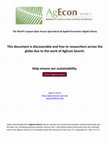
RePEc: Research Papers in Economics, 2010
The US and the EU have taken different paths in the design and implementation of biofuel support ... more The US and the EU have taken different paths in the design and implementation of biofuel support and enforcement measures. In the EU, indicative targets have been defined for biofuels, but a strict enforcement mechanism does not exist in practice. Also, mandatory targets have been approved voluntarily by several EU Member States. US biofuel policy has specified targets in absolute quantities rather than in percentages of use, as was done in the EU. Because of this quantitative target and the fact that enforcement is through a mandate rather than a less binding target, enforcement is assured but implementation problems arise (e.g., "blend wall") that may not occur in the EU system. In this paper, we provide an analytical discussion on lessons learned from the current and previous EU and US biofuel enforcement mechanisms and consider the possibilities, opportunities and challenges for future policy development in both economies.
RePEc: Research Papers in Economics, Feb 1, 1987
Staff General Research Papers Archive, 1988
Transition to agricultural market economies: the future of Kazakhstan, Russia and Ukraine
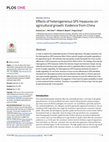
PLOS ONE
In order to explore the sustainable growth of Chinese agriculture, this paper assesses how the he... more In order to explore the sustainable growth of Chinese agriculture, this paper assesses how the heterogeneous SPS measures affect China’s growth margins and quality upgrading in the agricultural sector. We estimate improved gravity-model that exploit the cross-country differences in SPS measures over the period from 2000 to 2014. Our findings show that the heterogeneous SPS measures restrict the intensive margin and extensive margin, but significantly promote the product quality-even with no significant effect on price index. Conditional on quality upgrading, the heterogeneous SPS measures decrease the extent of quality upgrading. On one hand, because of cross-country differences in SPS standards, standards from developed countries have less effective trade effect on China’s agri-products export quality upgrading; On the other hand, because of cross-firm differences in the ability to deal with SPS standards, the laggards in China have the higher probability to switch to lower entranc...
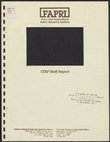
in some regions and years to maintain consistency between ending stocks and beginning stocks and ... more in some regions and years to maintain consistency between ending stocks and beginning stocks and between supply and demand. Data are on a crop year basis for the respective regions. In the tables, a "." indicates missing data. Annotated Index-Barley Country or Region* Page, United States 11 Production changed little between the early 60's and the late 70's before increasing slightly in the early 80's. Yields increased by 75% during the period, while area harvested declined substantially. Domestic consumption remained relatively constant, as food use increased and feed use declined. Food use accounted for over 40% of domestic consumption in the early 80's. Between 10 and 20% of production was exported in most years. Stocks accumulated in the late 60's, the late 70's, and in 1982. Canada 15 Production tripled during the period, due to increases in both yield and area harvested. Domestic consumption, primarily as feed, doubled during the 60's and remained relatively constant thereafter. Exports increased six-fold, with most of the increase occurring in the early 70's and early 80's. Stocks fluctuated considerably from year to year. Brazil 19 Country or Region Page Egypt 27 Production declined slightly due to a decline in area harvested. Food use declined, but feed use increased to account for two-thirds of domestic consumption in the early 80's. The country did not trade barley internationally in years after 1966. High Income North Africa & Middle East 29 Production changed little, as yield increased and area harvested declined. Domestic consumption tripled, with most of the increase occurring in the late 70's and early 80's. Feed use accounted for threefourths of domestic consumption at the end of the period, compared to just one-fourth .at the beginning. The region was a net exporter in the early 60's, but net imports supplied 60% of domestic demand in the early 80's. Other Low Income North Africa and Middle East 33 Production doubled between the early 60's and the early 80's, due primarily to increased yields. Consumption generally changed with production. Feed use accounted for 70% of consumption demand in the early 80's. The region was a net importer in some years and a net exporter in others, but net trade never accounted for more than 10% of production or consumption. Republic of South Africa 37 The country was a minor producer whose production increased four-fold during the 70's. Domestic consumption, primarily for food use, generally changed with production. The country imported barley in most years prior to 1974, exported barley in the late 70's, and was self-sufficient in 1981 and 1982. Central Africa 39 Production increased modestly until a sharp decline in 1974, when area harvested declined by 50%. Not until the early 80's did production again approach levels of the early 60's. Consumption moved with production, as the region traded only negligible amounts of barley internationally. East Africa 41 The region was a minor producer whose production increased rapidly in the 70's and early 80's. Food use accounted for all of domestic consumption. The region was essentially self-sufficient throughout the period. People's Republic of China 43 Production increased by 75% even as area harvested declined, due to a sharp increase in yield. Consumption generally changed with production. The country imported small amounts of barley at the beginning and the end of the period, and was self-sufficient in most years between 1966 and 1977. f Country or Region Page Japan 45 Production declined dramatically due to a sharp decline in area harvested. Domestic consumption declined only slightly, as a decline in food use was largely offset by an increase in feed use. Food use accounted for three-fourths of domestic consumption in the early 80's, compared to just one-third in the early 60's. Imports tripled between the mid 60's and the mid 70's before declining at the end of the period. Imports supplied about 70% of domestic demand in the early 80's. India 49 Production changed little between the early 60's and the mid 70's, but then declined at the end of the period due to a reduction in area harvested. Food use accounted for almost all of domestic consumption, which generally changed with production. The country exported negligible amounts of barley in the late 70's and early 80's, but was essentially self-sufficient. Other South Asia 51 Production, area and yield all remained essentially unchanged between the early 60's and the early 80's. Food use accounted for almost all of domestic consumption. International trade was negligible, except for small imports in 1972 and 1973. High Income East Asia 53 Production increased until the early 70's and then declined, due to a sharp decline in area harvested. Domestic consumption increased sharply between 1969 and 1971 and declined rapidly between 1979 and 1982. Food use accounted for about 70% of domestic consumption in the early 80's. Net imports were greatest in the mid 70's, but they still supplied one-fourth of domestic demand in the early 80's.
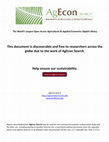
The speed of quality upgrading and export growth are out of sync. Export markets increasingly con... more The speed of quality upgrading and export growth are out of sync. Export markets increasingly concentrated in developing countries have become a new format for China's agricultural exports. The goal of this paper is to answer the question, "Is there a middle-quality trap in China's agri-products export under the incentive effects of heterogeneous sanitary and phytosanitary (SPS) measures?". For the first time, we expand the quality endogenous heterogenous firm trade model with multi-destination to explore the impact of SPS standards on the quality upgrading of agri-products from 2000 to 2014. The following results obtain: (i) the theoretical propositions show the answer is "YES", and the formation mechanism is attributed to the heterogenous SPS standards and the multi-destination export trade mode. (ii) Based on the firm-level panel data from China Customs, we improve the gravity model and use the Tobit method to test the theoretical propositions, which are also stable under the different measurements and regression methods, including the elimination of trade intermediaries and selecting labor-intensive agri-products. (iii) The negative effect of quality upgrading of SPS standards in OECD countries is greater than in non-OECD countries. (iv) Compared with the frontier firms, the probability of the laggards falling into the middle-quality trap is higher. We believe this provides a useful suggestion that is particularly well suited to the analysis of quality upgrading in an environment with heterogenous quality standards and multi-destination trade.
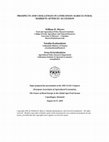
Medium-term prospects for key agricultural markets in Lithuania are analysed under alternative po... more Medium-term prospects for key agricultural markets in Lithuania are analysed under alternative policies. Policy alternatives show the impacts of EU accession and also the impacts of implementing AP reforms in 2007. The model is a partial equilibrium, multi-commodity model where commodity prices are linked to key prices in major EU markets. The accession analysis shows significant impacts on production, prices, and even on relative prices. It indicates impacts on production and trade patterns. The most realistic scenario (SAPS to 2006 and SFP from 2007 to 2010) generates a growth in product value more than 10 percent higher than the non-accession scenario. The largest increase is in the value of milk production. There also is a decline in crops share and increase in milk share of the total market revenue, while cattle and dairy together increase from about 35 percent of output value in 2002 to over 45 percent in 2010.
Paper prepared for presentation at the 104th (joint) EAAE-IAAE Seminar Agricultural Economics and... more Paper prepared for presentation at the 104th (joint) EAAE-IAAE Seminar Agricultural Economics and Transition: „What was expected, what we observed, the lessons learned."

Uploads
Papers by William H Meyers